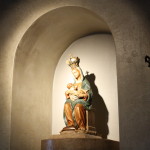So we’ve talked about how Marian doctrine taught me to celebrate my womanhood and how the Catholic idea of vocation honors women. But I want to share with you how learning about the saints and doctors of the Church taught me to love the diversity and strength of women in the communion of saints.

In Part II I shared how before converting to Catholicism, I felt that my gifts didn’t fit in anywhere in the church. It wasn’t until I started learning about the saints that I discovered that there is a place for everyone. Just because the Church teaches that men and women have different roles, that doesn’t mean that Catholic women are rigidly boxed into a narrow “type.” There are holy women that are completely different from each other and each Christian is called to display Christ’s love in a unique and beautiful way. If each of us were a stained glass window, we would have our own unique image to display the light of Christ.
So what kind of women are honored as saints of the Church?
There are warriors. St. Joan of Arc certainly didn’t fit into a traditional female role. Born a peasant, she was not a homemaker, mother, wife, or nun. She was a fearless military leader. Yet, she is held up as a model of Christian devotion. An interesting choice for a Church criticized for wanting all it’s women barefoot and pregnant in the kitchen.
There are mothers. A striking juxtaposition to St. Joan is St. Elizabeth Anne Seton, a fellow convert, loving wife and mother, and a lover of literature that was devoted to education and service. The first native-born American to be declared a saint! There’s also St. Monica, the holy mother of St. Augustine whose faithful prayers ushered him into the faith. Or St. Gwen, my confirmation saint, who gave birth to three saints, was kidnapped by Anglo-Saxon pagans, escaped twice, and was later martyred.
There are holy virgins. Take St. Lucy, for example, who fiercely defied being bullied into an unwanted marriage with a pagan Roman, undergoing the cruelest tortures her persecutors could imagine. She remained devoted to her Christian faith despite her torturers attempts to blind her, burn her, and send her to a brothel and was martyred for her faith.
No story is the same. No woman is the same. By holding up these amazing women for all Christians to emulate, the Church affirms that women are courageous, strong, persevering, faithful, intelligent, influential, and valuable.
Perhaps even more astonishing than the diversity of female saints, especially considering the inequality in education that women have encountered throughout history, there are four women who are named Doctors of the Church, a rare title that elevates their writings as greatly influential works that are helpful to the Church. To put this in perspective, there are only two popes who are named Doctors of the Church. I always thought that only folks like St. Thomas Aquinas, highly educated dead white guys, held that sort of honor. Not so. I think this speaks volumes to the respect the Church has for a woman’s mind. There’s certainly a higher percentage of women included here than I encountered in the texts studied in any of my Philosophy classes.
One of these amazing Doctors of the Church, St. Catherine of Siena, refused to accept the role her family had in mind for her: to marry well in medieval Italy. Instead, this holy woman devoted herself to a life of consecrated virginity. She was illiterate (until later in life when she was given the ability to read and write by supernatural means) but became the advisor of popes and political leaders. During a time of great turmoil for the Church, this strong and brave woman held great sway and blessed the Church with her holy guidance.
St. Therese of Lisieux, on the other hand, wasn’t a public figure by any stretch of the imagination and her desire was to serve God through “the little way” or the ordinary, every day tasks of one’s life. She lived a cloistered life and died very young of tuberculosis. Yet, the writings she left behind are honored next to those of popes and bishops. She is, in fact, the youngest of all the Doctors of the Church.
St. Hildegard of Bingen was a medieval abbess and a polymath, musician, poet, illuminator, philosopher, theologian, and visionary. During the era misnamed the “dark age,” St. Hildegard’s stunning intellect and writings shone with her vibrant faith. Even as a little girl, decades before my conversion, I was intrigued by St. Hildegard’s fascinating life and intelligence.
St. Teresa of Avila was a Carmelite nun, mystic, and influential writer of the Counter Reformation era. Her great works, such as The Interior Castle, are prized for their insights on the contemplative life and mental prayer.
Warriors, mothers, martyrs, aristocrats, peasants, academics or illiterate, there is room for everyone. Getting to know the saints has given me a new perspective of a “woman’s role” in the Church. It is not narrow. It is not rigid. There is a place for everyone to be celebrated for the gifts God has given them and the unique way they can serve his Holy Church.
The end of this series, Part IV, on Church teachings about marriage, fertility, and contraception coming soon.
(image source: lenarpoetry.blogspot.com, from Sacred Heart Catholic Church, Dover, NJ)


Love this! Your insights are so refreshing! Thank you again for taking on this monumentous subject.
Yet another great post! Looking forward to Part IV as those are perhaps my biggest passions as a Catholic wife and mother. Keep sharing your gift of writing!
I have been sying this about the church for months. I’m in my RCIA classes now. Many of my friends have questions about the Catholic church. I love refering them to the Youcat book and your blog!! <3
Hi Haley,
I’ve been sneaking peeks at your blog for a while. I’m in the gray area research phase right now, reading everything (books and blogs) that I can get my hands on about Catholicism. I’m a Protestant but am feeling powerfully drawn to the Catholic Church; I enjoyed reading your conversion story.
Since reading St. Augustine’s “Confessions” in college almost a decade ago (eep! I’m getting old!) I’ve always admired (and fallen woefully short of) St. Monica’s tireless prayer life, and recently have begun to invoke her in my prayers to pray that way for my children, my husband, and myself.
I noticed in your conversion story that both you and your husband were pretty much on the same page the whole way through your studies. My husband, also Protestant, is pretty skeptical of the Catholic church and doesn’t have much time for reading the books that I have been reading. Do you have any advice for me, as being the more interested party in the marriage yet also the wife and therefore called to submit to his leadership? Thanks, and God Bless!
This may help. I was in a similar situation, except my husband was a catholic of sorts. I went through a deep conversion experience in my mid 30. I wanted him to have the same experience.
I had been full of anger , tired having 5 children almost one after another. They have a medical term for it today.
Anyway to make a long story short, in my prayers I had this very strong thought……….you do your job and I will do my.
So I thought deeply about this, and spoiled him as much as I could.
Within about 3 weeks. Think because it was such a long time, he went to a priest and said I want what my wife’s got.
The priest explained all he needed to do was make an adult committment to God. He had received all the scare nets as a child but never made a committment as an adult.
My husband said, it was like a heavy weight had lifted , he always thought he had to earn his way to heaven, and was never sure that God really loved him.
Now for the first time He knew that He God was his Father and really loved him.
Hope this helps. Remember our Father loves him more than we can ever understand.
Peace and love always.
Carmel
Off topic-but I am loving Signs of Life during Lent. I feel like I get a little treasure each day. The chapters are great for a quick read (between bottles and diapers and …four kids, you get the picture..) with giant reflection. Thanks for the rec. :). Hope you are feeling well. No need to reply, just REST.
Thank you so much for your thoughtful and authentic posts. I am a 22 year old woman trying to glorify the Lord as an academic in computer science. I attended a Protestant school for my undergraduate years and felt the pressure to “make lemon bars” when I really am gifted for completely different work. This post was such an encouragement to feel confident serving God with the gifts he has blessed me with–even if they diverge from cultural ideals.
Lovely and very interesting.